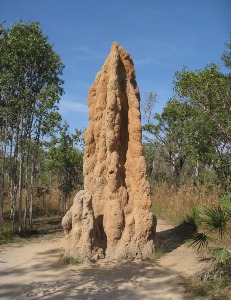
Recent developments have uncovered huge termite mounds completely covering a vast area in northeastern Brazil, previously covered by thick forests. These masses of earth can be up to three meters tall, and up to ten meters wide. They cover an area roughly the size of England. The combined mass of all the mounds can be seen from low earth orbit, though it is difficult to see individual mounds from that height.
It has taken over four thousand years for the mounds to get to the size they are today. They were created by the termite species,
Syntermites Dirus
. One of the largest species of termite in the world, these termites are usually very aggressive, and their bites can draw blood. They were a common food source for native local tribes long ago, and some of the remaining tribes today still eat them. The termites do not build the mounds to live in, like other termite species. Rather, the mounds are just the large piles of waste left behind from digging their vast tunnel systems.
The area covered by the termite mounds is over 230 thousand square kilometers, containing over 200 million mounds. Over time, the mounds have slowly grown and continue to grow through thousands of generations of termites continuously disposing their waste on them. They generate so much waste because they have a very long and intricate tunnel system. They have this system because the caatinga plant, which provides most of their food, only drops its leaves once a year. In order to survive, the termites need to take enough leaves, during that short period of time, and live off them for an entire year. Having a complex tunnel system can be really useful, allowing them to travel over vast distances, quickly and safely; it also provides a good place to store and hide their food after it is collected.
Unfortunately, the discovery also has a negative side. Previously, scientists were unaware of the termite mounds due to the area being hidden in thick rainforest. The reason they were discovered is that the area was deforested to create space for ranching. Deforestation is a big problem in this area and many other parts of the world. Many people are trying to reduce deforestation in Brazil.
Because these huge mounds have only been discovered very recently, much is still unknown about them. Once more scientists take notice and better satellite images are taken, maybe more can be learned about them. In the meantime, many mysteries remain. It is still surprising how something as big as this could have gone so long, undiscovered. Many scientists wonder what other big discoveries like this still remain hidden.
[Source:
gizmodo.com
]

